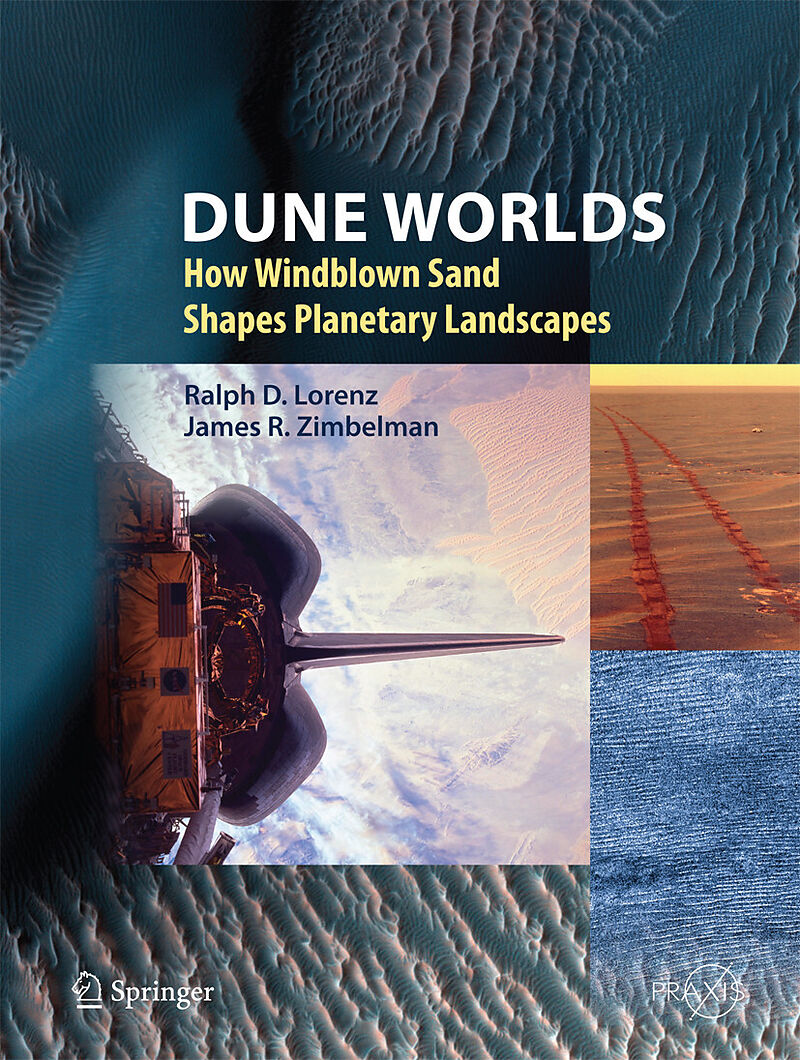Dune Worlds
Format:
E-Book (pdf)
EAN:
9783540897255
Untertitel:
How Windblown Sand Shapes Planetary Landscapes
Autor:
Ralph D. Lorenz, James R. Zimbelman
Herausgeber:
Springer
Anzahl Seiten:
308
Erscheinungsdatum:
22.04.2014
ISBN:
978-3-540-89725-5
Four major developments in dune research have occurred in recent years.Following the discovery of dunes on Saturn's moon, Titan, a whole new dimension has been added to aeolian studies.The vast amounts of data now coming in from Mars bring a new perspective to the abundant dunes on that planet.In the last decade, radar methods and high-resolution imaging have revolutionized the global observation of Earth's dunes.New instrumentation has improved field study capabilities, and powerful computational tools have opened new methods of simulating dune formation and evolution. Lavishly illustrated with over 300 photographs and figures, many in color, Dune Worlds covers all these developments to provide a unique and comprehensive overview of dunes, how we study them, and how they relate to their planetary environments.Lavishly illustrated with over 300 photographs and figures, many in color, Dune Worlds covers all thesedevelopments to provide a unique and comprehensive overview of dunes, how we study them, and how they relate to their planetary environments.
Autorentext
Dr Ralph Lorenz trained as an engineer (B.Eng. Aerospace Systems Engineering, Southampton 1990) and worked for a year for the European Space Agency ESA on the design of the Huygens probe and its instruments. He then spent three years obtaining a PhD at the University of Kent at Canterbury building part of the Surface Science Package which measured Titan's surface properties in January 2005. In 1994 he moved to the University of Arizona for postdoctoral research, where his interests have included Titan, Mars, climate, nonequilibrium thermodynamics and instrumentation. He continues these researches as a member of the Senior Professional Staff at the Applied Physics Laboratory of Johns Hopkins University, where he moved in August 2006. Relevant to the present book, he has published several papers on dust devils, surface modification processes, and Aeolian processes - most recently reporting the discovery of massive fields of sand dues on Titan. Lorenz has written over 100 papers in rherefereed literature and over 20 polular articls in magazines such as Spaceflight, Astronomy Now and New Scientist.James Zimbelman has been a Geologist at the Center for Earth and Planetary Studies, National Air and Space Museum, Smithsonian Institution, Washington, D.C for nearly 20 years. His principal interest is Planetary Geology - Geologic analysis of remote sensing data of Mars, geologic mapping of Mars and Venus, study of long lava flows on the terrestrial planets and field studies of volcanic, aeolian and pluvial features. He has published over 50 peer-reviewed papers and maps and several hundred abstracts
Zusammenfassung
This book describes how sand dunes work, why they are the way they are in different settings, and how they are being studied. Particular attention is paid to their formation and appearance elsewhere in the solar system. New developments in knowledge about dunes make for an interesting story like the dunes themselves, dune science is dynamic and the visual appeal of Aeolian geomorphology ensures that this is an attractive volume. The book is divided into 4 parts, the first of which introduces dunes as a planetary phenomenon, showing a landscape reflecting the balance of geological processes volcanism, impact, tectonics, erosion, deposition of sediments. Dunes are then considered as emergent dynamical systems: the interaction of sand and wind conspires to generate very characteristic and reproducible shapes. Analogies are given with other emergent structures such as patterned ground before the influence of dunes on desert peoples and infrastructure is studied, together with their use as forensic climatological indicators.Dune Physics is looked at with regard to the mechanics of sand, the physics of wind, saltation interaction of sand and air dunes versus ripples and transverse Aeolian ridges, the classification of dune morphology and the sources and sinks of sand. Dune Trafficability considers soil mechanics, effects on mobility on Earth, Mars and elsewhere.In the second part, Earth, Mars, Titan and other moons and planets are examined, beginning with a survey of the major deserts and dunefields on Earth. The authors then turn to Mars and its environment, sediment type, dune stratigraphy, sediment source and sinks and the association of dunes with topographic features. Titan follows - its thick, cold atmosphere, methane dampness, low gravity, morphology interaction with topography and the implications of dunes for climate and winds. Dunes elsewhere conclude this part. There are few dunefields on Venus, but there is a .possibility ofAeolian transport on Triton and volcanic-related windstreaks on Io.
Inhalt
Dune Physics.- Dune Trafficability soil mechanics, effects on mobility on Earth, Mars and elsewhere.- Earth.- Mars.- Titan.- Elsewhere.- Field Studies - Overview.- Laboratory Studies.- Computer Models.- Conclusions.

Leider konnten wir für diesen Artikel keine Preise ermitteln ...
billigbuch.ch sucht jetzt für Sie die besten Angebote ...
Die aktuellen Verkaufspreise von 3 Onlineshops werden in Realtime abgefragt.
Sie können das gewünschte Produkt anschliessend direkt beim Anbieter Ihrer Wahl bestellen.
Loading...
Die aktuellen Verkaufspreise von 3 Onlineshops werden in Realtime abgefragt.
Sie können das gewünschte Produkt anschliessend direkt beim Anbieter Ihrer Wahl bestellen.
| # | Onlineshop | Preis CHF | Versand CHF | Total CHF | ||
|---|---|---|---|---|---|---|
| 1 | Seller | 0.00 | 0.00 | 0.00 |
